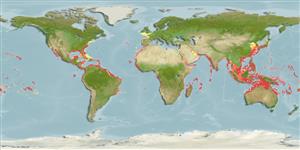>
Tetraodontiformes (Puffers and filefishes) >
Diodontidae (Porcupinefishes (burrfishes))
Etymology: Chilomycterus: Greek, cheilos = lip + Greek, mykter, -eros = nose (Ref. 45335).
More on author: Linnaeus.
Environment: milieu / Zona climática / intervalo de profundidade / distribution range
Ecologia
marinhas associadas(os) a recifes; intervalo de profundidade 20 - 100 m (Ref. 9680). Subtropical; - 24°S, 98°W - 34°W
Circumglobal: Gulf of Mexico, Atlantic, Indian and Pacific oceans.
Tamanho / Peso / Idade
Maturidade: Lm ? range ? - ? cm
Max length : 69.7 cm NG macho/indeterminado; (Ref. 89467); common length : 30.0 cm TL macho/indeterminado; (Ref. 26999)
Espinhos dorsais (total) : 0; Raios dorsais (total) : 12 - 14; Espinhos anais: 0; Raios anais : 11 - 14. Adults grey to brown with a black gular band and small black spots on upper surfaces and fins; pelagic juveniles blue with dark spots above, the spots descending to belly (Ref. 4423).
Body shape (shape guide): short and / or deep.
Adults found in reefs and over soft bottoms to depths of 100 m, but may occur deeper in the tropics (Ref. 30573). Often found washed up on beaches. Known to brace themselves against the substrate to sleep at night (Ref. 4930). Appear to be active during the day. Juveniles often with floating weeds (Ref. 48637). Solitary. Juveniles pelagic in oceanic surface waters (Ref. 30573). Feed on hard-shelled invertebrates. Not usually marketed.
Ciclo de vida ou comportamento de acasalamento
Maturidade | Reprodução | Desova | Ovos | Fecundidade | Larvas
Leis, J.M., 2001. Diodontidae. Porcupine fishes (burrfishes). p. 3958-3965. In K.E. Carpenter and V. Niem (eds.) FAO species identification guide for fishery purposes. The living marine resources of the Western Central Pacific. Vol. 6. Bony fishes part 4 (Labridae to Latimeriidae), estuarine crocodiles. FAO, Rome. (Ref. 9680)
Status na Lista Vermelha da UICN (Ref. 130435: Version 2025-1)
Ameaça para os humanos
Venomous
Uso pelos humanos
Pescarias: sem interesse
Ferramentas
Relatórios especiais
Baixar XML
Fontes da internet
Estimates based on models
Preferred temperature (Ref.
123201): 18.4 - 28.3, mean 27 °C (based on 959 cells).
Índice de diversidade filogenética (Ref.
82804): PD
50 = 0.5156 [Uniqueness, from 0.5 = low to 2.0 = high].
Bayesian length-weight: a=0.04677 (0.01905 - 0.11483), b=2.82 (2.61 - 3.03), in cm total length, based on LWR estimates for this (Sub)family-body shape (Ref.
93245).
Nível Trófico (Ref.
69278): 3.5 ±0.41 se; based on food items.
Resiliência (Ref.
120179): Elevada, tempo mínimo de duplicação da população menor que 15 meses (Preliminary K or Fecundity.).
Fishing Vulnerability (Ref.
59153): Low vulnerability (20 of 100).
🛈
Nutrients (Ref.
124155): Calcium = 18 [7, 59] mg/100g; Iron = 0.558 [0.274, 1.366] mg/100g; Protein = 19.2 [17.0, 21.4] %; Omega3 = 0.166 [0.086, 0.318] g/100g; Selenium = 25.4 [10.8, 56.7] μg/100g; VitaminA = 17.8 [4.5, 80.2] μg/100g; Zinc = 0.572 [0.367, 0.913] mg/100g (wet weight);
